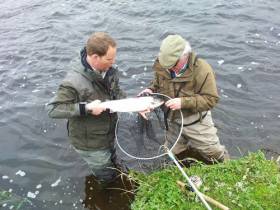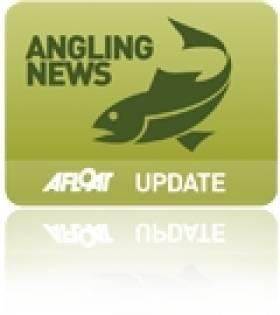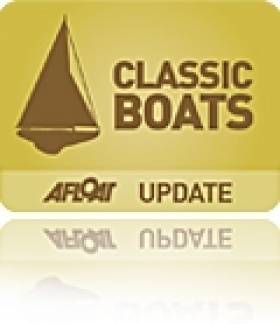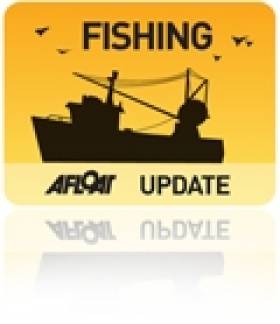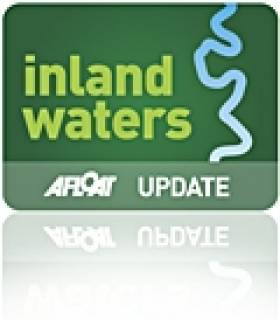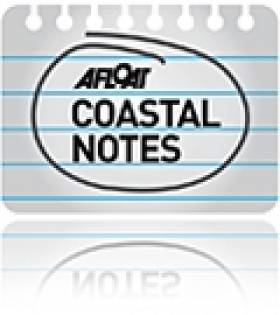Displaying items by tag: conservation
Wild Salmon & Sea Trout Tagging Scheme (Amendment) Regulations 2017 and Conservation Measures For 2018 Season
#Angling - Sean Kyne, Minister of State at the Department of Communications, Climate Action and Environment, gives statutory notice of his intention to make the Wild Salmon and Sea Trout Tagging Scheme (Amendment) Regulations, 2017 to provide for the management of the wild salmon and sea trout fishery by Inland Fisheries Ireland from 1 January 2018.
A copy of the draft regulations is open for public inspection at the offices of the department in Cavan and also at the offices of Inland Fisheries Ireland.
Any person may submit observations and.or objections to the draft regulations at any time during the period of 30 days concluding Thursday 14 December either by e-mail to [email protected] or to the following address:
Inland Fisheries Division
Department of Communications, Climate Action and Environment,
Elm House,
Earlsvale Road,
Cavan Town
H12 A8H7
Ireland
Tel (01) 6783071 / Lo-call 1890 449900 Ext 3071
Note that rates charged for the use of the 1890 number may vary between service providers.
All submissions received will be published on the department’s website following the conclusion of the consultation period.
Minister Announces New Sea Trout Tagging Scheme & Conservation Measures
#Angling - Sean Kyne TD, Minister of State at the Department of Communications, Climate Action and Environment, has given statutory notice of his intention to make the Wild Salmon and Sea Trout Tagging Scheme Regulations 2016 to provide for the management of the wild salmon and sea trout fishery by Inland Fisheries Ireland from 1 January 2017.
A copy of the draft regulations is available from the department website and and is also open for public inspection at the offices of the department in Cavan and at the offices of Inland Fisheries Ireland.
Any person may submit observations or objections to the draft regulations at any time during the period of 30 days concluding on 11 December 2016 either by e-mail to [email protected] or to the following address:
Inland Fisheries Division,
Department of Communications, Climate Action and Environment,
Elm House,
Earlsvale Road,
Cavan Town
H12 A8H7
Ireland
Tel: 01 6783071 / Lo-call 1890 449 900 Extension 3071
All submissions received will be published on the department's website following the conclusion of the consultation period.
Call For Anglers To Support Bass Conservation
#Angling - Inland Fisheries Ireland (IFI) has issued an appeal to bass anglers preparing for the season ahead to get involved in collecting information on bass in Irish waters for the National Bass Programme (NBP).
The programme was established by IFI to collect data on bass to provide scientific advice to support management and conservation of Ireland’s bass resource.
Bass anglers, as citizen scientists, have been collecting information for the NBP since 2013, thereby supporting bass stock assessment and increased understanding of the biology and ecology of bass in Irish waters.
To date, over 750 bass have been tagged and 3,000 adult bass scale samples have been collected. Scales are used to determine the age and growth rate of bass, while tagging provides information on migrations and habitat use.
The likelihood of additional recaptures is increasing with greater numbers of tagged fish at sea. Tagging results so far have shown that bass were recaptured generally within a few kilometres of their original capture site but some have travelled up to 38km. Time at liberty has ranged from three to 298 days.
By checking all bass for tags and reporting recaptures, anglers will help to discover additional information regarding movements of Irish bass.
IFI head of research and development Dr Cathal Gallagher said: “Ireland has always been a pioneer in terms of bass conservation and is showing progressive thinking in bass management by using the expert knowledge of anglers to collect information that would otherwise not be obtainable. We call on anybody interested in promoting bass conservation to contact IFI for information on how to get involved. All support is much appreciated.
“If you catch a bass with a yellow tag, or a fouled tag, please don’t remove it from the fish. Simply clean the tag and note the tag code (eg B-00001). If possible take the length and weight of the fish, and five scales from behind the pectoral fin, before you release the fish alive.
"Please send us the details, along with the date and location and your name and phone number by email or call IFI on 01-8842600. Information on the original bass tagging location and date will be provided to everybody who reports details to the IFI.”
IFI chief executive Dr Ciaran Byrne added: “Bass is an extremely important and valuable marine sport angling species in Ireland. It is a particularly valuable national resource, contributing €71 million to the Irish economy annually and supporting over 1,200 jobs nationally.
"Bass is an angling-only species so it is important that anglers, as guardians and custodians of this iconic sportfish, contribute information to support conservation orientated management.
"Some anglers are using voluntary logbooks to provide information on catches, angling effort, fish sizes and methods used. Scale sampling packs and logbooks are available from IFI and feedback on scales received will be provided to individual anglers outlining fish age, the year it was spawned and its growth rate.”
IFI has a dedicated email address at [email protected] to enable members of the public to report details on caught bass or to request information on how to support the NBP.
For more information, visit www.fisheriesireland.ie or call IFI at 01 884 2600 during office hours.
Minister Launches €240K Funding For Fisheries Development
#Angling - The 2015 Salmon Conservation Fund (SCF) and Midland Fisheries Fund (MFF) are now open for applications, Minister Joe McHugh has announced yesterday (Wednesday 15 April).
In total, €240,000 is available to conserve and develop the inland fisheries resource from funds generated through the sale of salmon licences and Midland Fisheries Area permits.
The schemes administered by Inland Fisheries Ireland (IF) will facilitate clubs, fishery owners, commercial salmon fishers and other organisations to undertake works to improve habitat, stocks, access, invasive species management and angling, under the supervision and direction of IFI.
The works undertaken are important in maintaining and improving capacity within the inland fisheries resource, which is estimated to contribute €755 million annually to the Irish economy.
Announcing the schemes, Minister McHugh said: “I am pleased to be able to support IFI in making these funds available to fisheries interests to allow for ground-up, managed sustainable development of the inland fisheries resources.
"Some wonderful projects have been supported since these funds have been established and I encourage all those interested in fisheries to investigate the possibilities under the various schemes to conserve, develop and promote their local fisheries.”
The Salmon Conservation Scheme has been in existence for eight years and has allocated funding to 184 salmon projects all around Ireland. €200,000 is available for distribution under this scheme in 2015.
The Midland Fisheries Fund, which is now beginning its third year, has seen 17 projects undertaken in the midlands area developing angling resources, supporting scientific research and conserving fisheries habitat. A further €40,000 is available under this scheme for 2015.
Full details and application forms are available on the Midland Fisheries Fund HERE.
Asgard: The Story of The Most Famous Yacht in Irish History Told This Wednesday At Howth Yacht Club
#hyc – Howth Yacht Club's Pat Murphy presents the life of Asgard, this famous yacht in Irish history from her launch in 1905 to her current conservation in Collins Barracks Museum and the 100th commemoration in 2014. The venue for the special talk is Howth Yacht Club this Wednesday, 18th February at 20:00. The lecture is open to all inlcuding non–yacht club members.
'Asgard's' 23 day voyage to collect the guns and ammunition for the Irish Volunteers and their landing in Howth in July 1914 is described in detail with unique photographs. Also covered will be the landing of Conor O'Brien's 'Kelpie' in Kilcoole.
Donations, no matter how small, will be welcomed on the night for the Howth 17s Heritage Fund.
New Lobster Measures Bad For Business & Stocks Says Fisheries Leader
#Lobster - Ireland's Marine Minister "is displaying no scientific understanding, and leaving older lobsters in the sea to die" in his new measures to protect lobster stocks, according to an inshore fisheries leader.
As reported yesterday on Afloat.ie, Minister Simon Coveney signed into law new conservation measures that introduce a new maximum landing size of 127mm, in order to preserve larger lobsters and enhance the reproductive potential of the stock.
The move follows the introduction earlier this year of an enhanced 'V-notching' programme to mark lobsters that should not be re-caught. And the minister has allowed for a two-year transition for lobstermen to avail of financial assistance to V-notch oversize lobsters and return them alive.
But Eamon Dixon, chair of the North-West Regional Inshore Fisheries Forum, told The Irish Times that fishermen would be put out of business by the "crazy" new landing size limit, well above the 89mm previously proposed.
Dixon added that the changes "will do nothing to protect the stock, and will only anger fishermen who had asked [the minister] to defer any change until the new regional inshore fisheries forums were up in action."
The Irish Times has more on the story HERE.
#lobster – The Minister for the Marine, Simon Coveney T.D., has signed into law, conservation measures as part of an integrated package to protect the long-term sustainability of lobster and shrimp stocks.
Lobster & Shrimp stocks are vital stocks for the important inshore fisheries sector and these stocks have been under increased fishing pressure requiring a number of conservation measures to ensure their sustainability.
In May, the Minister announced that the rate of financial assistance provided to fishermen for v-notching lobsters was increased to 75% of the market value. Figures from BIM, which administers the lobster v-notching programme, indicate that the number of lobsters v-notched in 2014 was more than double the numbers of recent years, with some €250,000 of funding supporting the return of more than 30,000 berried female lobsters to the sea this year.
As part of the Minister Coveney's announcement in May he also published the results of an extensive consultation process on lobster and shrimp management and announced that he had approved plans to revise conservation measures for these stocks. Following the success of the enhanced v notching programme for Lobsters and the completion of the consultation exercise the Minister is now enhancing the conservation measures further as part of an integrated approach. Under the new protection measures for lobster, a maximum landing size of 127mm is being introduced to support the reproductive potential of the stock. The retention of very large Lobsters in the Lobster stock are known scientifically to greatly enhance the reproductive potential of the stock and help to ensure its future sustainability.
Minister Coveney said, "I am greatly encouraged by the upsurge in v-notching conservation activity since my announcement in May. Lobsters are one of the most important species to the inshore sector and we need to work to ensure the long-term future of this valuable stock."
To ease the introduction of the new measure, during the first two years of this new measure's operation fishermen can avail of financial assistance for v-notching 'oversize' lobsters and returning them alive to the sea as a conservation measure. In the case of the shrimp fishery the new measures will see an earlier closing date of 15 March, instead of 1 May, commencing in 2015. This will improve stock protection during the critical shrimp spawning period.
Galway Town's Sewage Is Piped Into Conservation Area
#Turlough - TheJournal.ie reports that waste water from a whole town in Co Galway is being piped into a Special Area of Conservation.
According to an investigation by Ireland's national trust An Taisce, sewage from the town of Glenamaddy, home to some 700 residents in the north-east of the county, is being discharged in a local turlough - a lake that appears and disappears as the water table rises and falls - from which is has contaminated a nearby spring.
An Taisce described the town's present sewage unit as "primitive" and said: "It has been a subject of internal discussions within various public authorities for the best part of at least 20 years, yet the hazard continues to this day.”
TheJournal.ie has more on the story HERE.
Tánaiste Signs New Maritime Boundary Agreement
#MaritimeBorder - Tánaiste and Minister for Foreign Affairs Eamon Gilmore has signed a new agreement that establishes a fixed maritime boundary between the UK and Ireland's offshore areas, as The Irish Times reports.
Gilmore put pen to paper on the deal with British ambassador to Ireland Dominick Chilcott that finalises a single boundary between the Exclusive Economic Zones (EEZ) and continental shelves of both countries.
The agreement is expected to ease development of offshore energy projects, as well as improve fisheries protection and marine conservation in the EEZ, which lies above the continental shelf between 12 and 200 nautical miles off the coast.
However, despite the new deal, Ireland and Britain's differing claims over Rockall in the North Atlantic remain.
The small rocky islet, 228 nautical miles northwest of Donegal, is also claimed by Denmark and Iceland.
#MarineWildlife - UK environmentalists have expressed their disappointment at the British government's slow progress on developing its promised network of Marine Conservation Zones (MCZs), as the Belfast Telegraph reports.
The consultation period was for the proposals was set to end on Sunday 31 March - amid fears among conservation groups that were realised some months ago with the news that just 31 out of a potential 127 sites would be designated as protected for marine wildlife and plantlife by the end of this year.
It's being reported that Environment Minister Richard Beynon is blaming budget cuts and the high cost of scientific assessment for the slowdown in progress on the government's side.
"I want to do as many zones as we can for as little as we can," he told the BBC. "People have waited many years for this; we will designate the first tranche in September and will announce the next lot for consultation then."
The Royal Yachting Association (RYA) said in December that it was "encouraged" by the British government's "sensible" phased approach to the MCZ plans.
However, conservationists like Jolyon Chesworth from the Wildlife Trusts argue that their interests are being asked "to compromise on a compromise".
Chesworth added that the original 127 zones "were only nominated after very long discussions with anglers, sailors and the fishing industry".
The Belfast Telegraph has more on the story HERE.


























